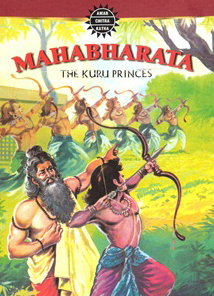Mahabharata (comics): Difference between revisions
No edit summary |
|||
| Line 48: | Line 48: | ||
The comics does not include the [[Harivamsha]] (a supplement to the Mahabharata), the romance of [[Damayanti]], the legend of [[Savitri and Satyavan|Savitri]] and the abbreviated version of the [[Ramayana]]. It also omits the character [[Ugrasrava Sauti]] and is recited by [[Vaisampayana]] to [[Janamejaya]]. |
The comics does not include the [[Harivamsha]] (a supplement to the Mahabharata), the romance of [[Damayanti]], the legend of [[Savitri and Satyavan|Savitri]] and the abbreviated version of the [[Ramayana]]. It also omits the character [[Ugrasrava Sauti]] and is recited by [[Vaisampayana]] to [[Janamejaya]]. |
||
== Influences and conflicts with other media == |
|||
| ⚫ | |||
Amar Chitra Katha series on Mahabarata (1985-89) coincided with [[BR Chopra]]'s famous television drama series ''[[Mahabharat]]'' (1988-90). Although, some fans took great pleasure in encountering Mahabharata in both mediums, the television series spelled big trouble for the comic book series. Amar Chitra Katha and the state-run [[Doordarshan]] television channel ([[DD National]]) competed for the same [[urban middle class]] audience.<ref>[http://books.google.co.in/books?id=V4-Su0whKa0C&dq=india's+Immortal+Comic+Books:+Gods,+Kings,+and+Other+Heroes&source=gbs_navlinks_s]</ref> |
|||
It is widely accepted that visual and narrative "homogenization" occurs between the ACK'S Mahabharata and BR Chopra's ''Mahabharat''. Television producers have repeatedly turned to the Amar Chitra Katha series as reference material for costume design, set production, and subject matter.<ref>[http://books.google.co.in/books?id=V4-Su0whKa0C&dq=india's+Immortal+Comic+Books:+Gods,+Kings,+and+Other+Heroes&source=gbs_navlinks_s]</ref> |
|||
ACK author Yagya Sharma explains: "When the ''Mahabharat'' television series was made, I had friend who was a cameraman at the set. And he told me that they often brought the ACK Mahabharata series onto the set and used it as reference material-for dress, the building, and also for the episodes, the content. It is Kamala Chandrakant who deserves credit for this. She was thorough and very, very careful with regards to authenticity."<ref>[http://books.google.co.in/books?id=V4-Su0whKa0C&dq=india's+Immortal+Comic+Books:+Gods,+Kings,+and+Other+Heroes&source=gbs_navlinks_s]</ref> |
|||
| ⚫ | |||
* The late 1980s saw the first of the collected format of the ''Mahabharata'' with a 7 volume "Library Edition".<ref>[http://www.comicology.in/2009/07/amar-chitra-katha-mahabharata-3-volumes.html]</ref> |
* The late 1980s saw the first of the collected format of the ''Mahabharata'' with a 7 volume "Library Edition".<ref>[http://www.comicology.in/2009/07/amar-chitra-katha-mahabharata-3-volumes.html]</ref> |
||
* A 14 volume special edition was published in the late 1990s.<ref>[http://www.comicology.in/2009/07/amar-chitra-katha-mahabharata-3-volumes.html]</ref> |
* A 14 volume special edition was published in the late 1990s.<ref>[http://www.comicology.in/2009/07/amar-chitra-katha-mahabharata-3-volumes.html]</ref> |
||
Revision as of 07:48, 7 January 2013
| Mahabharata | |
|---|---|
 Mahabharata (vol 1), by Ramesh Umrotkar | |
| Publication information | |
| Publisher | Amar Chitra Katha |
| Schedule | Alternative Title Schedule |
| Format | Limited series |
| Genre | Mythology |
| Publication date | 1985-89 |
| No. of issues | 42 |
| Creative team | |
| Written by | Kamala Chandrakanth, TMP Nedungadi, Subba Rao, Yagya Sharma, Lopamudra, Mihir Lal Mitra, Sumona Roy, Mohan Swaminathan, Shubha Kandhekar and Margie Sastry |
| Artist(s) | Dilip Kadam |
| Editor(s) | Anant Pai |
Mahabharata (also known as Amar Chitra Katha's Mahabharata[1]) is a comic adaptation of Indian epic poem Mahabharata. The 42-part best-selling series by Amar Chitra Katha was illustrated by Dilip Kadam.[2] The team of script writers (took turns to complete the 42 issues) included Kamala Chandrakanth, TMP Nedungadi, Subba Rao, Yagya Sharma, Lopamudra, Mihir Lal Mitra, Sumona Roy, Mohan Swaminathan, Shubha Kandhekar and Margie Sastry.[3]
The Mahabharata is often regarded as one of the most popular title in the history of Amar Chitra Katha. It is also the longest series (42 issue run on an alternative title schedule; from 329-441 [1985-89] in over more than 1300 pages) to have been produced by the ACK. It is said that the series was originally planned for 60 albums, but it was later cut short to 42.[4]
The comics does not include the Harivamsha (a supplement to the Mahabharata), the romance of Damayanti, the legend of Savitri and the abbreviated version of the Ramayana. It also omits the character Ugrasrava Sauti and is recited by Vaisampayana to Janamejaya.
Influences and conflicts with other media
Amar Chitra Katha series on Mahabarata (1985-89) coincided with BR Chopra's famous television drama series Mahabharat (1988-90). Although, some fans took great pleasure in encountering Mahabharata in both mediums, the television series spelled big trouble for the comic book series. Amar Chitra Katha and the state-run Doordarshan television channel (DD National) competed for the same urban middle class audience.[5]
It is widely accepted that visual and narrative "homogenization" occurs between the ACK'S Mahabharata and BR Chopra's Mahabharat. Television producers have repeatedly turned to the Amar Chitra Katha series as reference material for costume design, set production, and subject matter.[6]
ACK author Yagya Sharma explains: "When the Mahabharat television series was made, I had friend who was a cameraman at the set. And he told me that they often brought the ACK Mahabharata series onto the set and used it as reference material-for dress, the building, and also for the episodes, the content. It is Kamala Chandrakant who deserves credit for this. She was thorough and very, very careful with regards to authenticity."[7]
Collected formats
- The late 1980s saw the first of the collected format of the Mahabharata with a 7 volume "Library Edition".[8]
- A 14 volume special edition was published in the late 1990s.[9]
- A hard-bounded 3 volume edition in 1998 (reprinted in late 2007, 2012)[10]
